






YOUR MUST-STOP BEFORE HUNTING & FISHING ON PRINCE OF WALES ISLAND, ALASKA

KNOWLEDGEABLE STAFF WILL LET YOU KNOW WHERE, WHEN AND HOW!



















YOUR MUST-STOP BEFORE HUNTING & FISHING ON PRINCE OF WALES ISLAND, ALASKA

KNOWLEDGEABLE STAFF WILL LET YOU KNOW WHERE, WHEN AND HOW!











PUBLISHER
James R. Baker
GENERAL MANAGER
John Rusnak
EDITOR-IN-CHIEF
Andy Walgamott
OFFICE MANAGER / COPY EDITOR
Katie Aumann
LEAD CONTRIBUTOR
Frank Jardim
CONTRIBUTORS
Jason Brooks, Larry Case, Scott Haugen, Phil Massaro, Mike Nesbitt, Paul Pawela, Nick Perna
SALES MANAGER
Paul Yarnold
ACCOUNT EXECUTIVES
Colleen Chittich, Riland Risden, Diana Medel Robles, Mike Smith
DESIGNER
Lesley-Anne Slisko-Cooper
PRODUCTION ASSISTANT
Kelly Baker
WEBMASTER / INBOUND MARKETING
Jon Hines
Volume 12 // Issue 5 // February 2023
INFORMATION SERVICES MANAGER
Lois Sanborn
ADVERTISING INQUIRIES
ads@americanshootingjournal.com


Longtime American Shooting Journal columnist Scott Haugen bagged this coyote, one of several predator species that can be called in from the same stand in late winter. Haugen shares how! (SCOTT HAUGEN)
Website: AmericanShootingJournal.com
Facebook: Facebook.com/AmericanShootingJournal
Twitter: @AmShootingJourn
MEDIA INDEX PUBLISHING GROUP 941 Powell Ave SW, Suite 120, Renton, WA 98057 (206) 382-9220 • (800) 332-1736 • Fax (206) 382-9437 media@media-inc.com • www.media-inc.com

30 TRIGGER CONTROL
An accurate gun, good ammunition and a sharp eye will only get you so far when it comes to hitting your target, whatever that may be. Jason Brooks – a longtime big game hunter, target shooter and detective – details the mechanics behind triggers and how to master them to become a better shot.
52 USING GAME CAMERAS TO MAXIMIZE YOUR TIME AND HUNTING EXPERIENCE
No doubt about it, modern trail cams will help you better pattern the critters you want to hunt and save time over scouting, but there are a few device setup tricks to know too. Nick Perna shares advice that will have you hunting smarter, not harder.
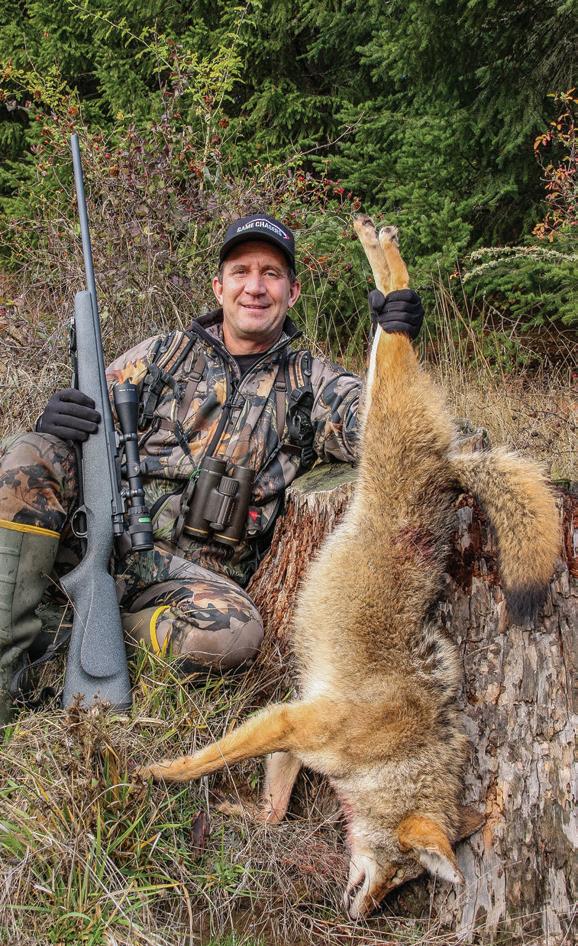
57 BULLE T BULLETIN: FOR THE LOVE OF LEVERS
When it comes to selecting ammo for this classic American rifle, modern or vintage, there are choices galore, and nobody knows that better than our professor of projectiles, Phil Massaro. He has a look at the “pleasures and pitfalls of lever gun ammo” through the decades, as well as today’s best cartridges.
71 BL ACK POWDER: THIS ‘TRAPPER’ IS A KEEPER!
Speaking of lever-actions, Mike Nesbitt got ahold of a used super-shortbarreled carbine in .44-40, a black powder cartridge rifle known as a “trapper” that’s also long on historical connection and shooting fun.
79 SC ATTERGUN ALLEY: SHOTGUN PICKS FROM SHOT SHOW 2023 Larry Case is still sore from walking all the aisles at January’s big Shooting, Hunting and Outdoor Trade Show, but he gamely provided us with a look at some of the new 12- and 20-gauges, shotshells and gun cases that caught his eye in Las Vegas.

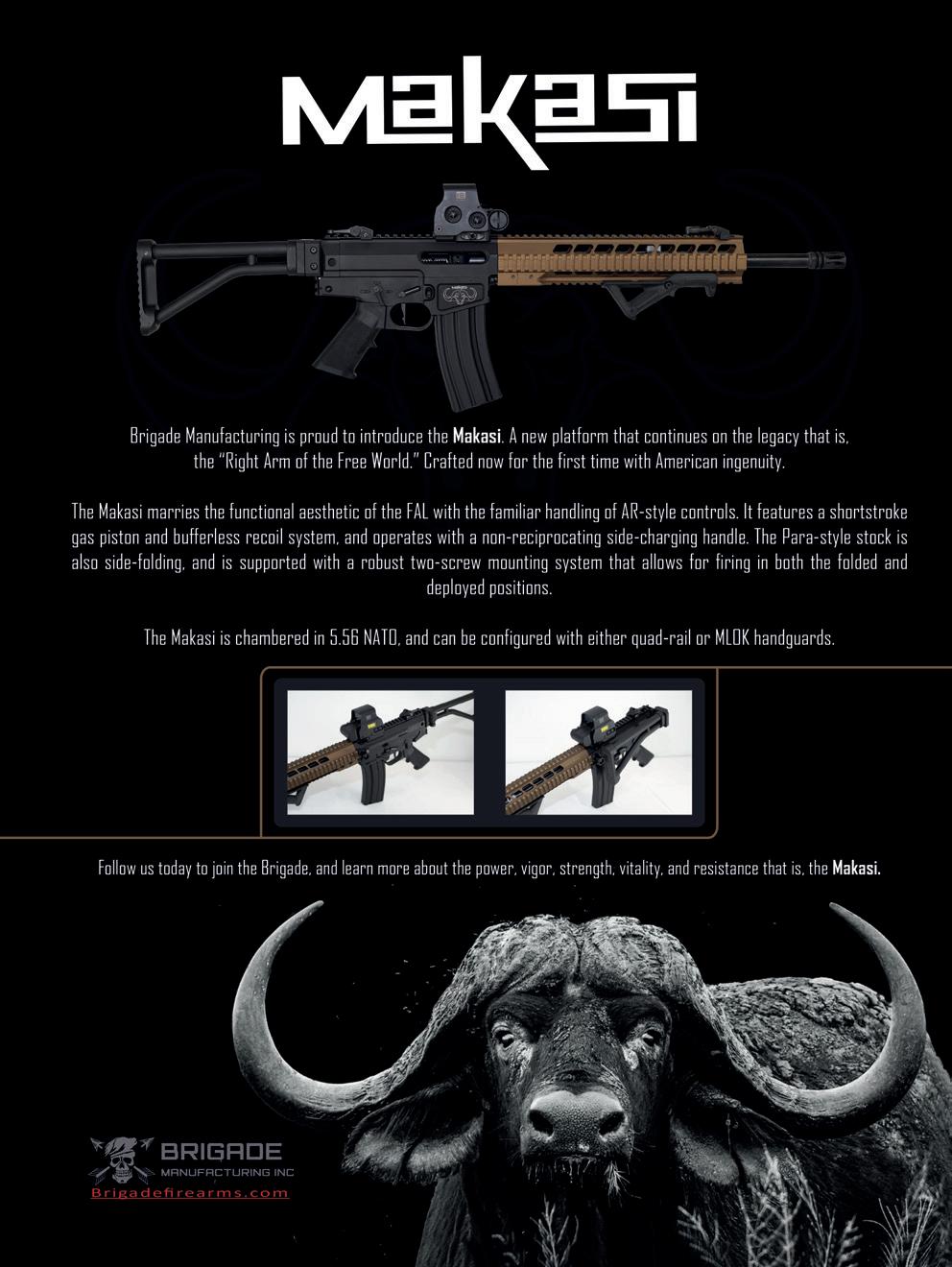

89 SELF-DEFENSE TRAINING: ON ‘THE BIBLE OF GUNFIGHTING’

If Paul Pawela is anything, he’s a student of history, and when it comes to the book on gunfights, there’s none better than Edmundo and Elizabeth Mireles’s FBI Miami Firefight. Pawela shares details and lessons from the historic 1986 firefight between G-men and bank robbers that changed how the bureau, law enforcement and others train.

97 L AW ENFORCEMENT SPOTLIGHT: A MARINE AND COP TO HIS CORE
Decked out in his dress blues at the Marine Corps Ball, off-duty California cop Fernando Ramirez could hardly have imagined witnessing a car crash and having to save the driver’s life – twice. But that’s just what his dual training taught him to do. Nick Perna shares Officer Ramirez’s duty-bound heroics.
23



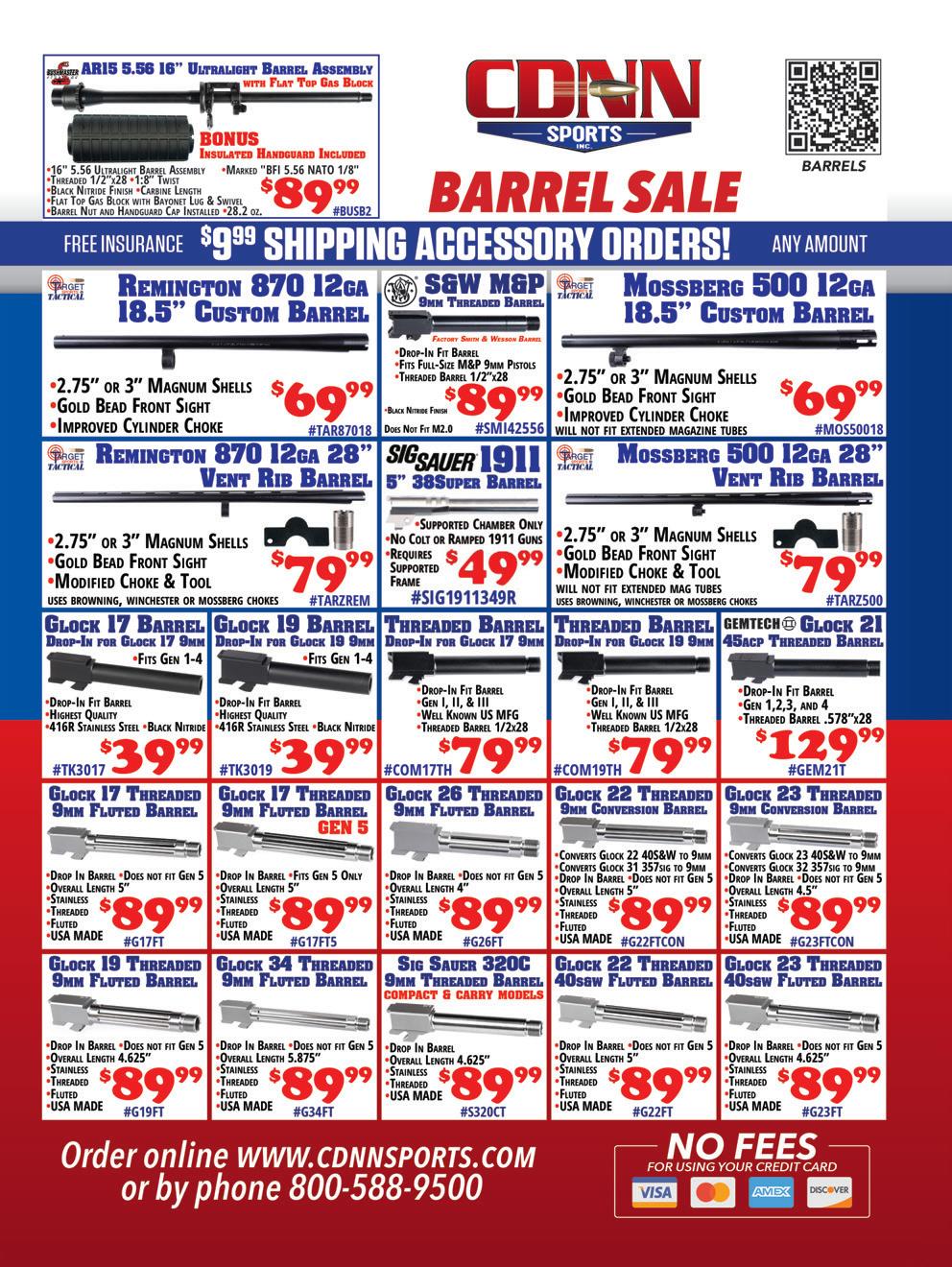

C&E Gun Shows
Crossroads Of The West Gun Shows crossroadsgunshows.com
Florida
RK Shows
Real Texas Gun Shows therealtexasgunshow.com
Tanner Gun Shows tannergunshow.com
Wes Knodel Gun Shows
February
Note: Covid-19 restrictions have largely been eased across the country, but always confirm events before attending.

usashooting.org
February 12
Ohio State University
JO Pistol
Columbus, Ohio
February 14-18
TWS Feb Training Camp
Colorado Springs, Colo.
February 18
Colorado State JO & NTCSC
Colorado Springs, Colo.
February 18-19
Team Shooting Stars
Feb PTO
Carrollton, Texas
February 24-26
Utah Feb PTO/State Pistol
Junior Olympics
Salt Lake City, Utah
March 9-12
March Smallbore Pistol Ranking Match
Colorado Springs, Colo.
uspsa.org



gssfonline.com
February 16-19
Florida Open 2023
Frostproof, Fla.
February 25-26
Western States Single Stack Championship
Mesa, Ariz.
March 4-5
Tarheel 3 Gun
Shotgun Blast
Clinton, S.C.
March 22-26
2023 Roadrunner Shootout Clovis, Calif.
March 23-26
2023 South Carolina
Section Championship Belton, S.C.
cmsaevents.com
idpa.com
February 4-5
Volusia County
GSSF Match
New Smyrna Beach, Fla.
February 11
Charleston Glock Challenge
Ridgeville, S.C.
February 10-12
SW Regional Championship
Queen Creek, Ariz.
February 11
Defensive Pistol Match at the Armory
Fulton, Ohio
February 18-19
Northern Florida Regional Classic Midway, Fla.
March 4-5
The Ouachita Regional Challenge
West Monroe, La.
February 15-18
CMSA Winter US Championship
Queen Creek, Ariz.
February 17-26
Winter Classic
New Castle, Pa.
March 11-12
River Bend Ballistic Challenge
Dawsonville, Ga.
March 18-19
Emerald Coast Glock Classic Holt, Fla.
March 10-11
Southeastern Regional Championship
Perry, Ga.
February 24-25
2023 South Florida Defensive Challenge
Homestead, Fla.
Note: Covid-19 restrictions have largely been eased across the country, but always confirm events before attending.

February 18 2023 MDT Frostbite
February 25
Frontline Fury
March 4 Clay’s Cartridge Company Classic
March 4 Snake River Standoff
March 11 MPA Spring Shootout
March 18
March 25
Central Coast Chaos
VPRC Rifleman’s Revival 2023
April 1 B&T Ind. LLC Box Canyon Showdown
April 15
Koenig-Ruger PRC – AG Qualifier


April 22 2023 A-Team PRC
April 29 2023 Leupold Best in Texas

Butler ville, Indiana
Warrenton, North Carolina
Leedey, Oklahoma
Bliss, Idaho
Swainsboro, Georgia
San Luis Obispo, California
Rocky Mount, Virginia
Medicine Lodge, Kansas
Grand Junction, Colorado
Carbon Hill, Alabama
Navasota, Texas
For more information visit www.precisionrifleseries.com

2023
CLASSIC PRS MATCH –AG QUALIFIER
Navasota, Texas
January 28, 2023
1st Place
AUSTIN BUSCHMAN Open Div.
176.000/100.000
2nd Place (tie)
CHRIS KUTALEK Open Div.
CHAD HECKLER Open Div.
CLAY BLACKKETTER Open Div.
173.000/98.295

American Shooting Journal publisher James Baker had a blast at the 2023 Shooting, Hunting and Outdoor Trade Show in Las Vegas, walking the aisles, meeting advertisers, checking out all the new products, manning our booth and more. Here are some of his great photos from SHOT Show!


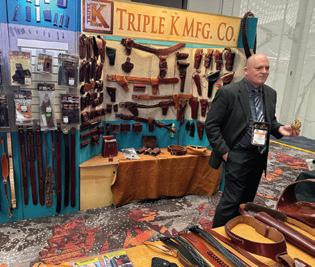








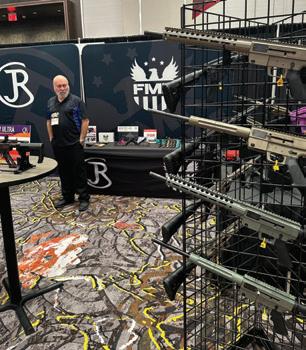


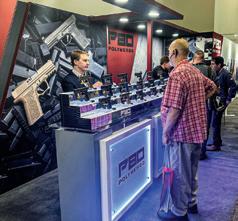






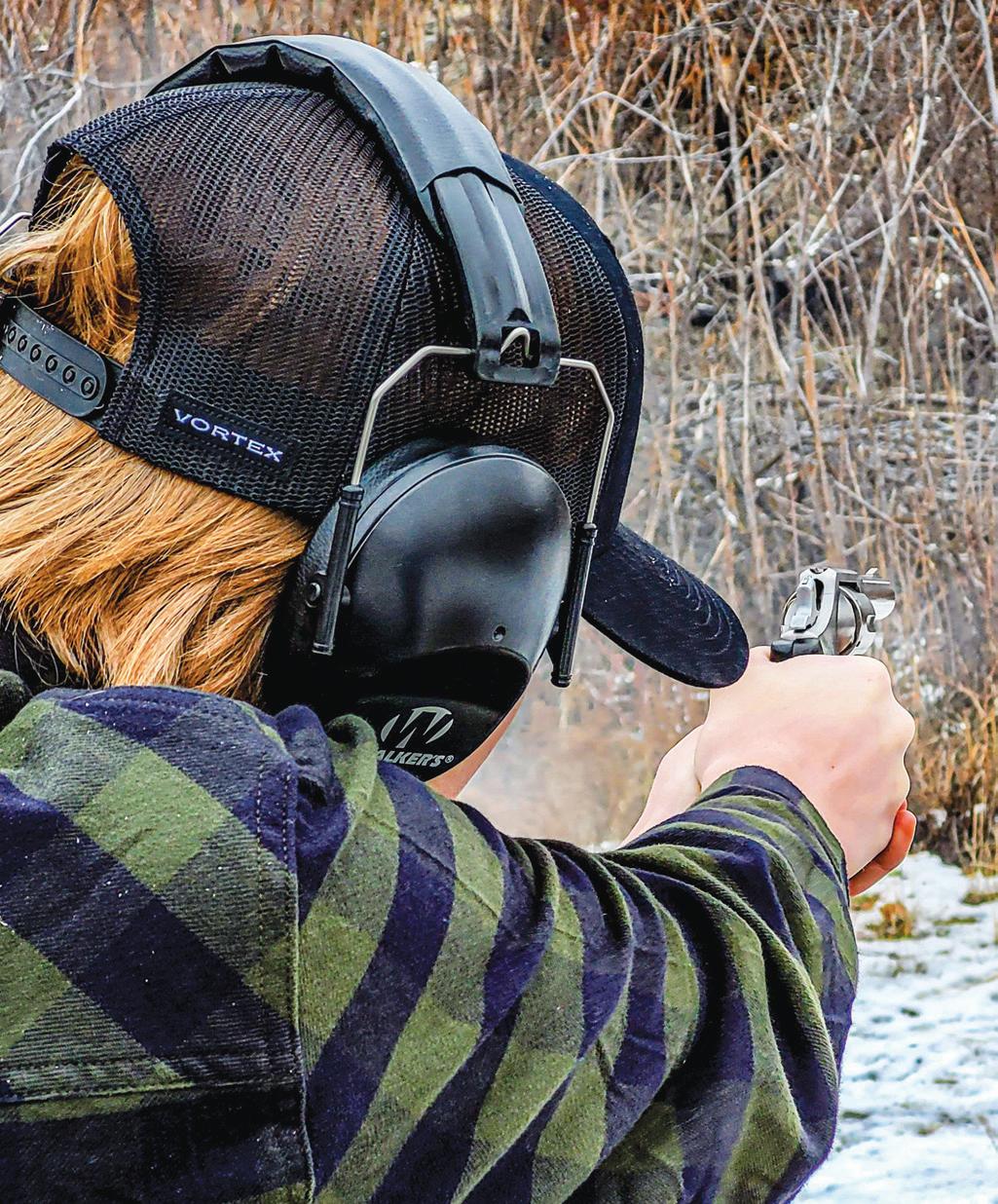

Shooting a firearm is not overly complicated, but shooting a firearm accurately can be.
Regardless of what kind of gun you are shooting, they all have one thing in common: a trigger. The trigger is often only given a fleeting thought by the shooter while aiming, but it is the most important part of shooting. After all, you can’t make the firearm go “bang” without pulling the trigger and you can’t hit your target if you do it incorrectly.
There is a lot that goes into shooting a gun, but whether it’s a rifle, shotgun or handgun, all of them fire by pulling a trigger. The basic concept of a trigger is that it is a lever that is pulled, putting pressure on or disengaging the sear, which is another lever that then releases a spring. This causes the firing pin to strike the primer of the cartridge, causing it to fire.
There are two different ways that the spring causes the firing pin to move. One is a spring putting tension on a hammer that is then released and it strikes a pin or has a point on the
An accurate gun, good ammo and a sharp eye will only get you so far when it comes to hitting your target, whatever that may be.STORY AND PHOTOS BY JASON BROOKS There’s a saying, “front sight to win the fight,” but trigger control is just as important for hitting your target.
hammer itself that strikes the primer. This is most common in singleshot rifles, muzzleloaders and some handguns, such as the model 1911 and all revolvers. The other way is a spring-loaded firing pin, also known as a striker, is released and moves forward, striking the primer. This is most commonly found in bolt-action rifles, pump and semiauto shotguns, and semiauto handguns and rifles.
There are also two primary types of actions or trigger groups that are used. The first is the single-action, which is where you cock the hammer (like most muzzleloaders and 1911-style handguns) or a springloaded firing pin (such as a bolt-action rifle) and simply apply light pressure on the trigger to disengage the sear. This releases the stored energy of the spring on the hammer or firing pin, moving it forward and causing the gun to fire. The second action is called the double-action, and this is where one pull of the trigger both cocks the firearm and releases the hammer or firing pin. Most revolvers are both double- and single-action, meaning you can do either with them. The semiauto firearm often uses gases or internal springs that cock the action after each shot by mechanical means.
Depending on which action – either single or double – you are shooting can determine how you pull the trigger. The trigger also has what is known as “travel,” which is how far or “long” you have to pull the trigger before it fires, and “overtravel,” which is how far the trigger can continue to be pulled after the gun fires. For semiauto handguns, there is also trigger reset, which is where it reengages the sear and is ready to fire again.
One other factor is how much force it takes to pull the trigger, which is measured in foot-pounds and is often called “trigger pull.” Most single-action handguns have a trigger pull of 3 to 5 pounds, while most hunting rifles have a trigger pull of 2 to 5 pounds. Double-actions have trigger pulls from 8 to 11 pounds, but there are some variations of this as well, depending on manufacturer. Handguns rarely have adjustable

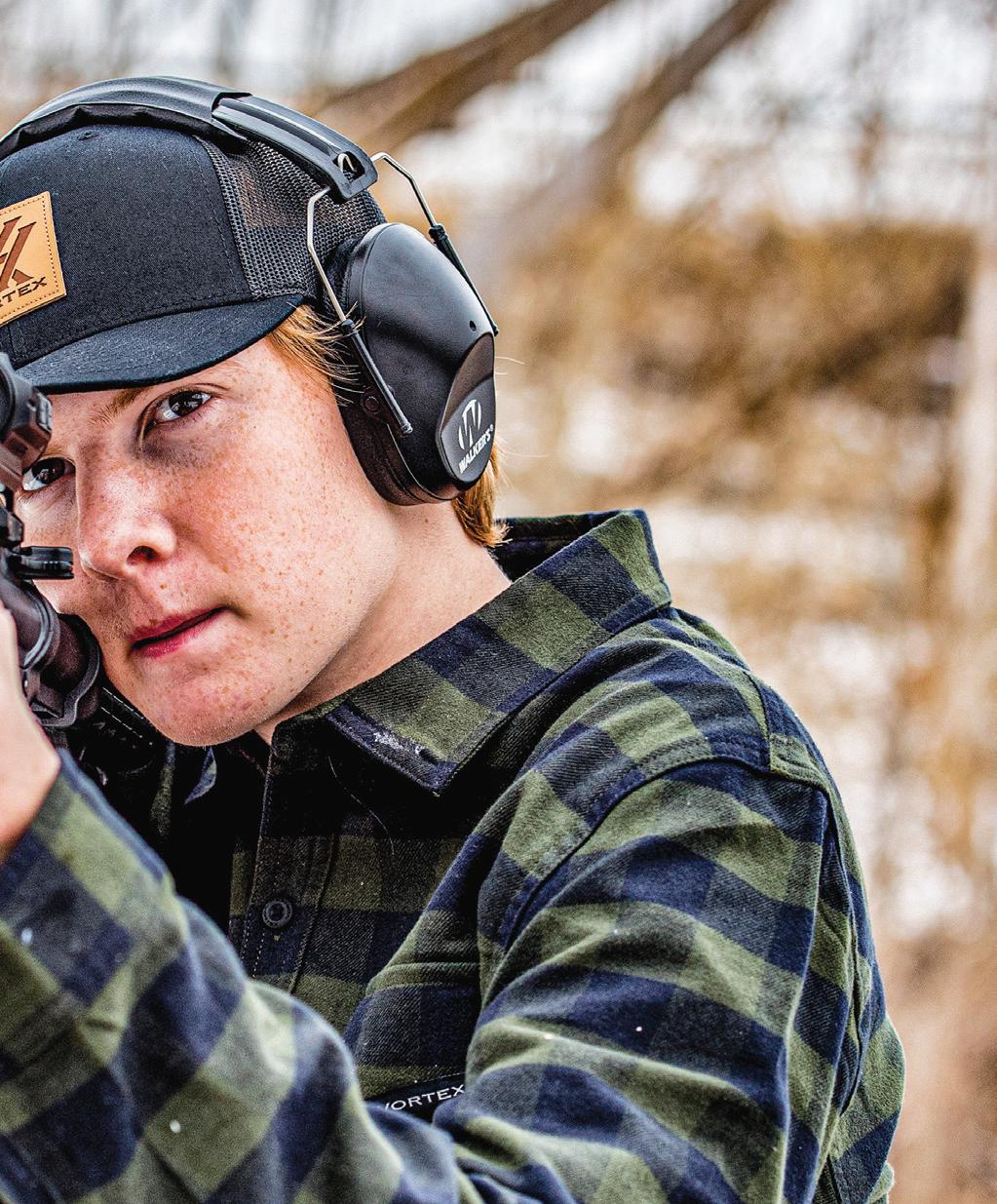
Even with red dot sights, you still need to practice trigger control to be accurate under pressure.
triggers, while some hunting rifles have easy-to-adjust triggers. Almost all guns can be fitted with an after-market trigger if you find the one you have is just too hard to shoot accurately.

THAT IS THE basic concept of how a trigger works, but it is the pulling or controlling of the trigger that can affect accuracy. A common bad shooting habit is jerking the trigger, where the shooter moves their trigger finger quickly and yanks on the trigger hard, causing the gun to move around while firing. A smooth and steady trigger pull is the key to shooting accurately as you steady the firearm.
Nearly 30 years ago I found myself in the quartermaster’s office as a newly hired police recruit. The quartermaster was a salty cop, one who had been removed from the streets either for his own safety or for the safety of others, but he knew his stuff when it came to equipment.
All of us new recruits were issued our gear, including uniforms, gun belt, baton, handcuffs and our duty handgun. Back then, the department had just transitioned from a Glock to the Beretta model 96D, with the “D” standing for “double-action only.” The rumor was that the change was made because an officer accidentally fired his weapon while climbing over a fence and had it in his hand. The knee-jerk reaction was to issue a gun that was harder to fire, and so the double-action Beretta became standard issue.
I will admit that I did not give it much thought at the time, but that old streetwise officer pulled us aside. He gave a piece of advice that later saved me and almost cost a fellow recruit his job. The quartermaster explained how the double-action worked, which was that 11 pounds of pressure had to be pulled by your finger on the trigger with no way to cock the hammer; just
pull it back and it would eventually go “bang.” Two problems: the 11 pounds of pull weight and the extremely long trigger travel. Both caused hand fatigue and made for an “inaccurate” gun. In reality the gun was very accurate, but it took so much strength to fire it that most shooters pulled the gun off target before the firing pin struck the primer.
To overcome this, the quartermaster suggested a drill. We were told to put a quarter – yes, a 25cent piece – on top of the slide of the handgun and, while empty, aim it at a small target and pull the trigger. The suggestion was to point the gun at something exceedingly small in a safe direction and see if you could keep the front sight on the object or aiming point and repeatedly pull the trigger without knocking off the quarter. He added that if you could do this 10 times in a row, then you would have the “feel” of the trigger and be able to
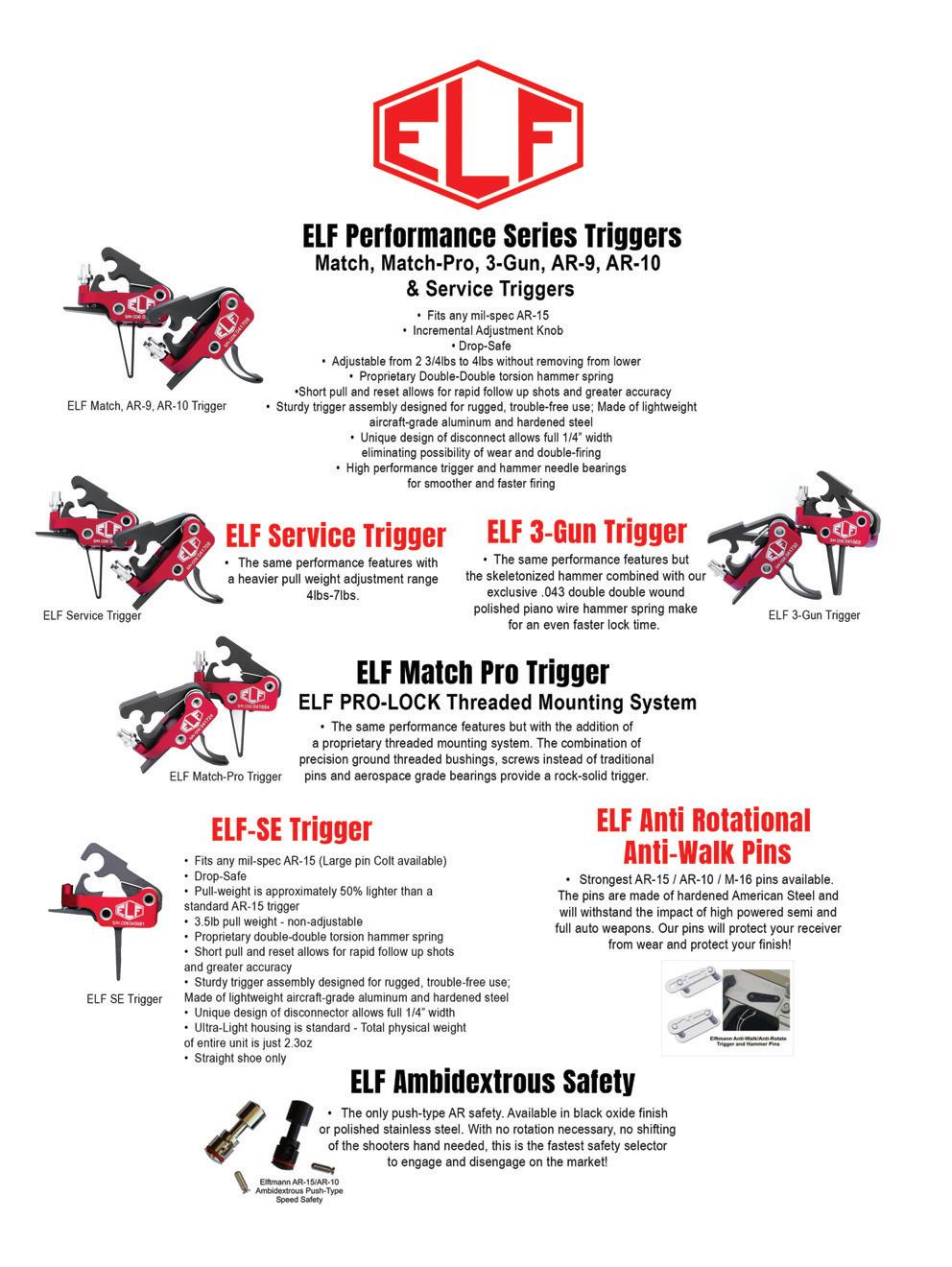
shoot the handgun accurately. It took me months of practice to be able to reach the goal of 10 trigger pulls without the quarter falling, but when it came down to the final qualifications at the academy, I passed with excellence, shooting well above 90 percent. My classmate, who thought he knew more about the Beretta than anybody else since he shot one in the U.S. Army, barely passed. This was because he was used to the model 92F, a single-action handgun that has a much easier and lighter single-stage trigger once cocked.
THIS IS WHERE I began to learn the importance of pulling the trigger to shoot accurately. Poundage
is a key factor in precise shooting. Some benchrest shooters and oldtime snipers from the Civil War used a two-stage trigger that had a “set trigger” and then the main trigger. By pulling the set trigger, you reduced the poundage and trigger travel on the main trigger, making it a “hair trigger.” That term most likely came from the lack of travel or the need to only pull the trigger as slight as a hair is thick.

Very few firearms today use set triggers, but most hunting rifles and some after-market triggers allow the shooter to set the poundage. By shooting a light trigger, you can fire the weapon without having to impart much pull on it. This is imperative for light rifles such as the many sub-6pound rifles on the market today used by backcountry hunters. The harder or more poundage it takes to pull the trigger, the more likely you will move the firearm while shooting it. But there is such a thing as “too light” of a trigger, keeping in mind that it is a mechanical lever that is engaged with the sear. If the trigger does not have enough resistance or poundage, then you can fire it too soon, or worse yet, cause it to fire when it is not safe to do so. This highlights the importance of keeping your finger off the trigger until ready to fire. A good “safe” trigger weight of pull is around


3 pounds, which can be easily pulled by the index finger and not cause movement of the firearm.
Trigger travel, or “trigger creep,” is the length that the trigger travels before it disengages the sear. Often this small gap is lighter than the weight of the trigger poundage and is easier to pull. The exception to this is with the double-actions, where the poundage is steady throughout the travel. When shooting a firearm with a longer trigger creep, it can cause the shooter mental fatigue. This is especially true in precision shooting when you are pulling on the trigger just waiting for it to go off, often holding your breath, which causes muscle fatigue and shaking. When it
comes to handguns, trigger travel can also cause you to push the firearm forward as you anticipate recoil. If you are shooting good groups but they are low, it is likely that you are pushing the handgun forward as you pull the trigger.
The break of the trigger is when it finally goes bang. This is the pivotal moment of firing the weapon. If you have ever shot a Glock, then you know that distinctive trigger break. Pull lightly until you hit the “wall” and then apply just enough pressure to cause the trigger to break. The wall, or trigger break, is something the shooter should be cognizant of because if you pay attention to the trigger break then you are
concentrating on the shot. It shouldn’t be a surprise when the firearm fires. For the handgun hunter, this means keeping the front sight on target, and for the scoped or red-dot optical shooter, this is the concentration of the reticle on target as you pull through the wall.
Overtravel is what happens after pulling the trigger through the wall and it fires. Shooters who jerk the trigger can cause movement of the firearm, especially during overtravel; this is most common with doubleaction firearms, as now the trigger pull goes from hard to noticeably light. Another way the shooter can cause inaccuracy is to pull the firearm or tilt it just as it fires and before


the bullet leaves the barrel. This is a common occurrence in handgun and lightweight rifle shooting.


Trigger reset occurs in semiauto firearms and this is where the trigger is released and re-engages the sear so it is ready to fire again. Regarding accuracy, the trigger reset doesn’t impart too much movement of the firearm but it does make a difference for speed of followup shots. It also allows the shooter to forgo the trigger
travel if you learn to stop the trigger once it resets. Let’s go back to the Glock, as their triggers are easy to learn and feel. Once you fire the handgun, you can hold the trigger and then slowly release it; you will feel a slight bump and hear a “click.” The trigger has now reset and is ready to fire, as it is already up against the wall of the trigger break. This is only about ¼ inch of movement. Once you learn to use trigger reset, you can minimize
slapping the trigger or pushing forward, as there is no travel creep and you should still be on target from the first round being fired.
JUST LIKE YEARS ago when I did the quarter-on-the-slide drill for the double-action Beretta, it takes a lot of practice to control the trigger. There are several drills and it all depends on the action of the firearm. Benchrest shooters use extremely heavy rifles and set triggers with a “hair” firing trigger. Most hunters and shooters don’t have these luxuries. You can mitigate some of this by learning to take up the creep or to adjust the trigger so there is minimal travel, by choosing a light but safe trigger pull poundage, and by learning not to move the firearm during overtravel. Practice is the key after you make the adjustments to the trigger or if shooting a firearm that does not have an adjustable trigger.
A smooth, consistent trigger pull all the way through the travel, past the break and overtravel is what makes for an accurate shot.
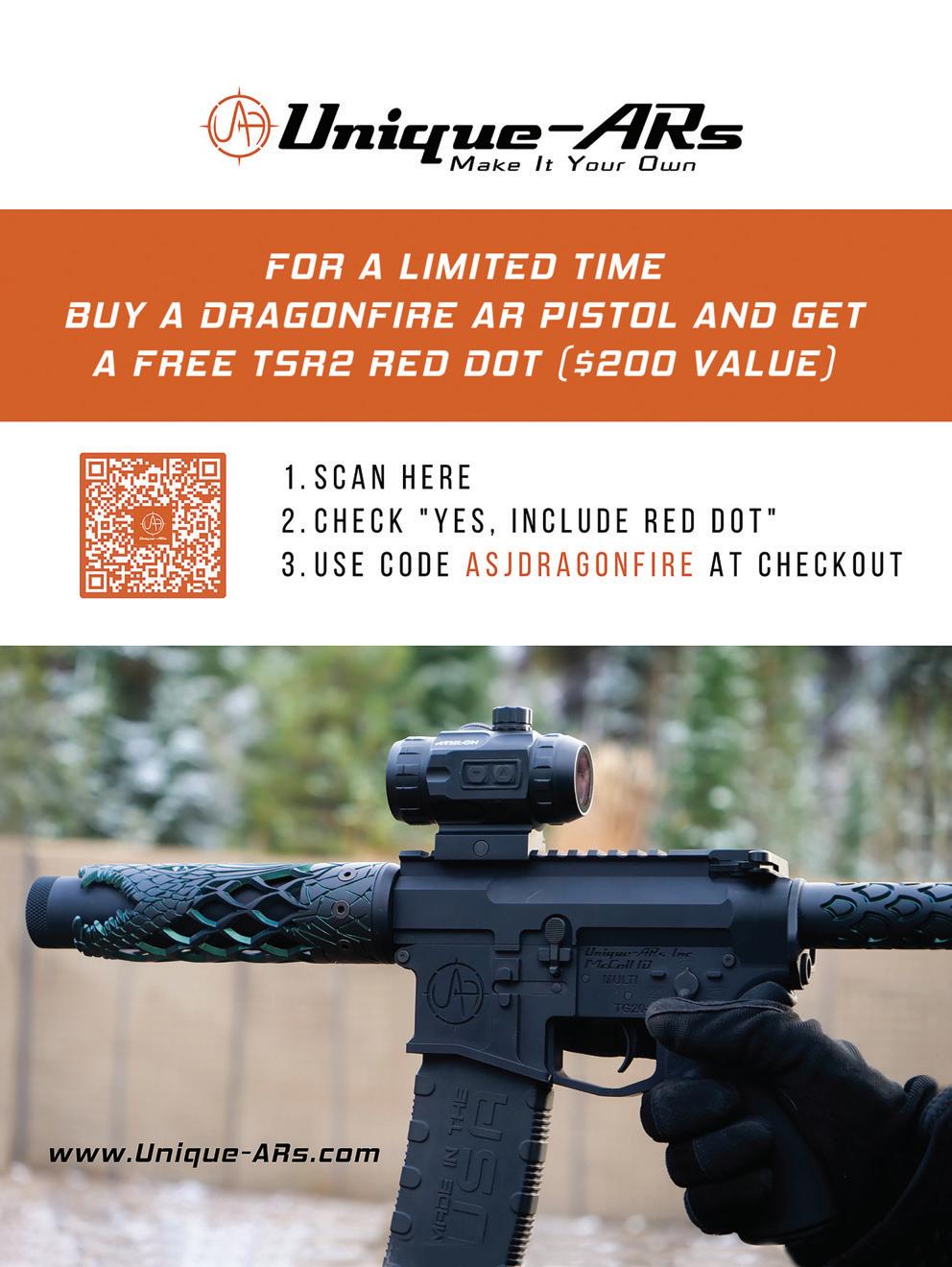

When it comes to predator hunting the West, you never know what might come to a call. While coyotes are the go-to target species when calling in open, high-desert habitat, bobcat, gray fox, red fox, cougar and even badger can be called in too.

The key to success when it comes to bagging multiple predators out West lies in research, proper setups, diversified calling and being ready to close the deal when a shot opportunity presents itself.
Trail cameras are a major part of predator hunter success throughout the West. Trail cameras reveal what predator species live in an area, what time of day or night they’re moving, which direction they’re heading and how many animals are out there. Trail cameras are your eyes in the woods when you’re not there, and I set up as many as I can, wherever I go.
Fencelines, game trails, secondary logging roads and the corners and edges of farm fields are places I routinely hang trail cameras. When on a road trip, I’ll set them in areas where I’m hunting for a few days. In places closer to home, I have them out year-round.

From coyotes and fox to bobcats and badgers, good calling plus solid setups can yield a variety of shooting ops from the same stand across the West.
STORY AND PHOTOS BY SCOTT HAUGENIt’s not often that gray fox are taken in daylight amid the thick habitats they call home in the West, but in the right place at the right time, anything is possible.
What can be learned about predator populations from a trail camera is humbling. A few years ago I switched from snapping photos to capturing animal movement on video mode on all my game cameras. If a picture is worth a thousand words, a 10-second video clip is worth 10,000. What you can learn from watching the behavior of predators and hearing what goes on out of frame will greatly influence how you hunt an area. Seeing a coyote as it walks by a camera is one thing; seeing a coyote walk by with a howling pack just out of frame is another. As a caller, such discoveries instill confidence, as you now know there are multiple predators competing for food.
If you really want to study predators, invest in quality trail cameras that transmit clear footage. My trail camera of choice is Stealth Cam’s DS4K Ultimate. The quality of clips these things capture is impressive. I’ve used
them in Alaska, the Western U.S. and into Mexico, and have had them covered in several feet of snow, drenched in rainforest downpours and exposed to 100-degree temperatures, and they’ve never let me down.
When traveling roads, look for tracks and droppings, telltale signs that predators are in the area. On trees, fence posts and where trails cross under barbed wire fencing, look for hair. Make a mental note of all well-worn trails, as predators are creatures of habit.
If traveling to hunt in another state, call regional fish and wildlife authorities for direction. Ask them about predator trends, what species they’re seeing high numbers of, and where they could use help keeping predator numbers in check. In your research, ask if any recent big game surveys have resulted in seeing high numbers of predators; this will typically be coyotes in areas with good mule deer populations.

Don’t forget to ask if they have a list of landowners seeking predator relief.
While coyotes are the cornerstone species in the world of Western predator hunting, noting the habitats they live in is the real key to discovering other predators in the vicinity. By being aware of what habitats predators like bobcat, fox, badger, cougar and even bear live in, and then preparing, setting up and calling accordingly, you’ll be on the way to discovering what’s really out there.
“When targeting coyotes, I like setting up in the open so I can see a long way,” shares good friend and noted guide Brandon Ayres of Arrowhead Outfitters (541-980-1597) in The Dalles, Oregon. “Coyotes always try to quickly move downwind, and I want to see them before they smell me. Bobcat and cougar are another story. When calling where cats are, I

like setting up in brush, making sure my back is covered and the outline of my body fully hidden should a cat approach from below.”
Buddies and I targeted coyotes in the dense Douglas fir forests of the Cascade Mountains and more than once over the years we took a mixed bag. Using dense cover was instrumental in our hunts, but occupying heavy shadows was also a major benefit. When targeting multiple predators at once, setting up in thick cover, utilizing heavy shadows
and playing the wind are all essential to success.
While not all predators approach your calls in the same manner, they will respond to the same sounds. As for the calls, Ayres likes mimicking the food sources in the area he’s hunting, and mixing them up. “We’ve had luck on just about everything over the years, from all kinds of rabbit distress sounds, fawn distress calls, even rodent sounds work very well.”
Not long ago I was calling in the rolling sagebrush hills with willowlined draws in the desert Southwest. There was a jackrabbit boom in the area; the most I’d seen in well over a decade. So, that’s the sound I went with.
Over the course of the morning, I called in seven coyotes from four different sets. That evening I returned to the same region, focusing my calling in the shaded draws rather than the more open ridges. I called in two more coyotes, along with a bobcat and gray fox, and all with a mix of jackrabbit distress sounds.
I’m a firm believer in having a range of bird distress sounds at your disposal, too. I’ve used bird sounds to coax in coyotes, badgers, bobcats, raccoons and black bears. I like using open-reed mouth calls, as they allow for a great variety of sounds to be generated, including bird sounds.
“In February I really like pup distress sounds,” points out Ayres. “Male coyotes really react to those sounds this time of year.”
Ayres doesn’t use a whole lot of coyote vocalization other than that, largely due to the availability of food in the area he hunts, but also because he has a good chance of calling in a bobcat or cougar in most places.
“Like many hunters around the West, we’re having more and more cougars come to elk calls during archery elk season,” he confirms. “We also have bears come to the calls from time to time. They seem to respond very well to fawn distress sounds in the spring.”
Mixed bag predator success simply comes down to being within earshot of predators, then offering them a sound they can’t refuse. “I like using mouth calls,” points out Ayres. “I have better control of the sounds I make, and I think it brings in more predators than the electronic calls I’ve used. But I do use electronic calls, I just don’t place them very far from me when calling in places where bobcats and cougars are. These cats can hang back in the brush before making a move on a food source, and



the closer the electronic call is to me, the better chance I have of seeing cats.”
Ayres also likes using a batteryoperated decoy placed by his e-call, both to attract the attention of predators and keep their sharp eyes off of himself.
Ayres is a thinker, and one thing I’ve noticed during my years of hunting with him is that he likes moving when in the field. Some might judge this as fidgety, but I attribute it to his knowing the land and the animals exceptionally well, and optimizing the opportunities to close the deal.
“I’m not one to sit for 45 minutes or an hour waiting for a cat to come in,” Ayres smiles. “Most of the bobcats and cougars we’ve called in over the years have shown up within the first 15 minutes of calling, and many in
the first five minutes. If they’re close, they’ll likely come in right away, and this is where I think hunters need to set up with that in mind, and be ready to shoot before even offering a series of calls. When it comes to predators, it’s all about being in the right place and catching them in the right frame of mind.”
When calling in brush country throughout the West, many predator hunters carry both a rifle and shotgun. Having the rifle set up in shooting sticks with the shotgun by your side is the norm. If you catch sight of a nearby predator moving through brush, grab the shotgun.

Ayres spends a lot of time glassing for predators, too. This is more indicative of what predator enthusiasts envision when thinking of hunting out West. On my last hunt with Ayres,
we glassed up a pair of coyotes in a canyon, which we were able to move closer to before setting up. I ended up dumping both yappers.
“In big, open country, you can see predators moving from a long way, throughout much of the day,” confirms Ayres. “Covering ground with your eyes is a great way to locate predators, then you can figure out a game plan from there.”

While coyotes range from the top of the Rocky Mountains to the beaches of the Pacific Coast – and everywhere in between – don’t overlook habitats that hold other predators when hunting the West. In sagebrush country and farmlands between the Rockies and the Cascades, badgers can be targeted. Like coyotes, badgers love bird distress sounds.
As you move into river drainages,
Nestled in the foothills of the Ozark Mountains in Missouri, High Adventure Ranch offers all of the excitement of western big game hunting without the costs and hassles.

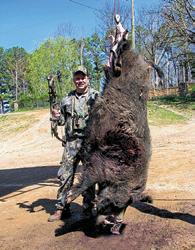

Be prepared for a fair chase hunt! With over 3 square miles of prime natural habitat, our ranch provides challenges to even the most seasoned hunter, but our experienced guides and “No Game, No Pay” policy practically ensure that you won’t go home empty handed. In addition, High Adventure’s hunting season is year-round, allowing ample time to fit the most demanding schedule.
While our whitetail, elk, wild boar and red stag hunts top our hunter’s most popular lists, hunters from around the world have visited our ranch, hunting everything from American bison, black buck, fallow deer to Spanish goats and African game.
So, whether you desire a 10-point whitetail mount for your trophy room or simply the thrill and challenge of taking down one of our many elusive big game animals, High Adventure Ranch guarantees memories of an unparalleled hunting experience that will bring you back again and again.


don’t forget about the possibility of bringing in a red or silver fox. One time while calling red fox on Alaska’s Kodiak Island, I had a bonus silver fox come trotting in, which I slipped an arrow through. Oftentimes when calling predators out West, you never know what will come in.
Do your homework, cover country, and don’t be afraid to tuck tight into
cover before calling, as that’s key to punching a mix of predators. Be sure to check furbearer regulations in states you’ll be hunting, and have the proper license and tags with you.
Look for favorable habitats that are home to multiple predators, don’t be afraid to offer a range of prey sounds – from screaming birds to distressed big game – and cover ground. With so

much land to hunt and so many places for predators to be, taking your sounds to where the predators live is key to realizing mixed bag success.
Editor’s note: For signed copies of Scott Haugen’s bestselling books, visit scotthaugen.com. Follow Scott’s adventures on Instagram and Facebook.



 Use game cameras to hunt smarter, not harder, says author Nick Perna.
Use game cameras to hunt smarter, not harder, says author Nick Perna.

You can be more efficient in figuring out what critters are up to by patterning them with trail cams, but there are a few setup tricks to know so you don't waste time.
STORY AND PHOTOS BY NICK PERNATime is a fleeting commodity. No one has enough time to do everything they want to do. As hunters, we all wish we had the time to scout out properties to their fullest extent – watching trails, looking for animal sign (prints and scat), and taking note of the times of day, week, month and year when they are most active. In earlier times, man depended much more on subsistence hunting
for food, so scouting was necessary to locate and take game. Today most hunters like to take game but don’t necessarily survive on what they can take. To get the meat we need, we use money earned from jobs, which take up most of the time our forefathers would have used to scout for game.
Enter the game camera. With a minimal investment and an equally minimal amount of time, a hunter
can use these electronic scouts to gather accurate, timely data about when and where game can be located and harvested.
There are two primary types of game cameras: those you can access remotely and those you can’t (models with memory cards).
Remote-access models can be monitored via an app on a smartphone,
tablet or laptop. They are very handy for far away or hard-to-access areas. If you need current, up-to-the-minute data, this is the way to go. They cost between $100 to $400 apiece. These models also require a SIM card, and cellular data/service fees apply.
Memory-card models require the owner to go to the camera’s location to remove the SIM card. They are cheaper, between $50 to $100. Make sure to use the largest memory cards accepted by your camera model. With the lower price point, you can purchase more of them and they are better for covering a large area.
The ability to take images at night is essential. Most game cams have this function, but make sure you check. Look into rechargeable batteries if your camera isn’t solar-powered.
When placing game cameras, there are many things to consider.

Location Check frequently after initial deployment to determine if it is a worthwhile location. More often than not, the initial spot you choose will not ultimately be where you decide to leave it for extended periods of time.
Make sure there is a good field of view. It’s not enough to pick a spot where game sign has been located. You also need to be able to position the camera in a way that it can actually capture images or video. In certain
instances, I’ve used a wood or metal stake with a game cam mounted to it to get the best images.
Either mark your camera points on a paper map (old school) or pinpoint them on a mapping application. Those little camouflage boxes are hard to spot when you go out to download or retrieve them! Take a photo of the location so it helps refresh your memory.

Trigger warning Look out for branches, tall grass, windy areas and areas with heavy vehicle traffic. This is arguably the most frustrating thing about game cams. Depending on the settings, they can be triggered by very little movement. I recently pulled a
game cam’s memory card that had 15,000 images taken in a period of less than a day! It was placed in an area with some high grass. During a windy day, the camera took pics of the grass every couple of seconds. On another occasion I mounted a camera facing a road. All I got was images of cars passing by. (If you have a remotely accessed camera that sends notifications every time it takes a photo, this can drive you crazy.)
Bring something to cut down grass, branches and other things that will ruin your shot. A pair of garden shears or a knife will usually suffice.
Security (aka thieves) Game cameras are easily stolen, especially if mounted on public land. If the game camera has a strap on it to hold it in place when attached to a tree, make sure you camouflage it. That’s about the only thing a would-be cam thief is most likely going to see.
Apply gathered intel Keep a journal of times, types of game, etc. This will allow you to optimize your hunting time and increase the chance of locating and taking the game you seek. Be prepared to move cameras that are not capturing any relevant images. Utilize a mapping app to show not only locations of cameras but game as well. Apps like onX Hunt allow you to easily geotag locations on maps.
Bottom line: Use game cameras to hunt smarter, not harder.

REVOLUTIONARY NEW 2-PIECE NAS3 CASE TECHNOLOGY: 50% LIGHTER THAN BRASS
Coated Aluminum Base
• Less wear on ejector pin

• Can be color coded for ID/branding
High Tensile Nickel-Alloy Cylinder
• More consistent performance
• Higher tensile strength and elasticity
• Corrosion resistant
• Reloadable using S3 Reload dies

UNLOADED CASES AVAILABLE FROM SHELL SHOCK TECHNOLOGIES. 9MM CASES AVAILABLE NOW, OTHER CALIBERS COMING SOON. SEE WEBSITE FOR MANUFACTURERS OF LOADED AMMO

WWW.SHELLSHOCKTECH.COM

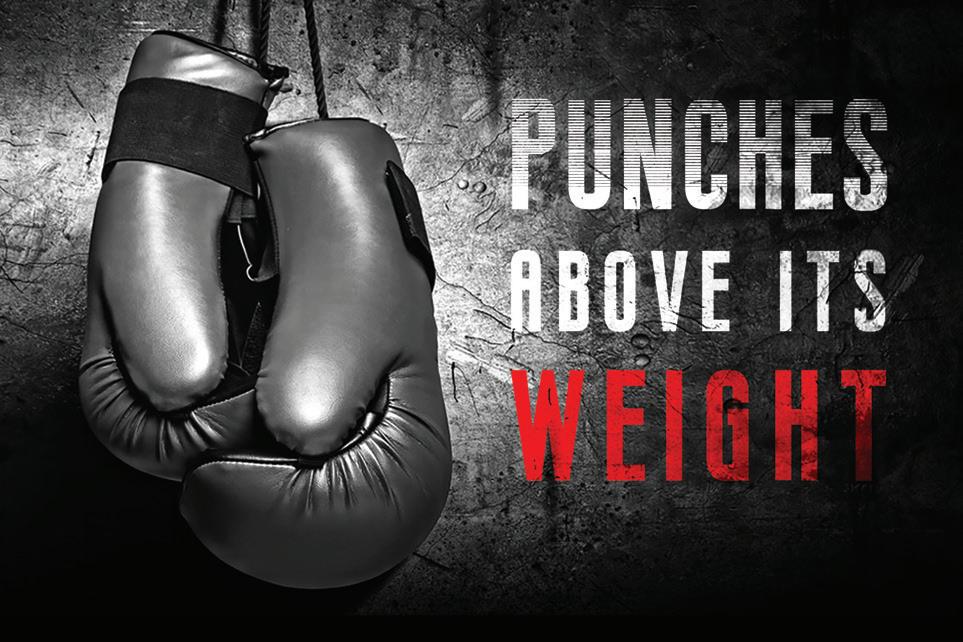


The lever-action rifle remains one of America’s most iconic designs, and in spite of all the advancements in polymer stocks, weatherproof metal coatings and longrange cartridges, grabbing a wood-


stocked lever gun and heading to the woods remains a fantastic experience.
From the traditional lever-action rifles with tubular magazines, which hearken back to the 19th century, to the more modern designs of the early to mid-20th century, which employed box magazines, there is probably a lever gun for everyone. However, the design of the gun might dictate the type of ammunition
you can use in that particular model. Let’s take a look at the pleasures and pitfalls of lever gun ammo.

RIGHT OUT OF the gate, be aware that if you do choose a lever gun with a box magazine – and the Savage 99 and Browning BLR come quickly to mind – you can shoot any type of bullet you’d like, including the sleek,

modern spitzer designs. It is the rifles with tubular magazines that have the handicap; using a spitzer bullet in that magazine can result in the ugliest of magazine detonations, potentially killing the shooter. You see, the
cartridges are lined up nose-to-tail and the pointed meplat of a spitzer bullet could, in theory, puncture the primer of the cartridge ahead of it, causing the cartridge to start a chain reaction in the magazine.


To avoid the possibility of magazine detonation, those tubular-magazine rifles were traditionally relegated to using flatnose or roundnose projectiles, so there was no risk to the shooter. In spite of the relatively low velocities – at least in comparison to what came after the turn of the 20th century – those round- and flatnosed projectiles didn’t really offer the flattest of trajectories. However, when one considers the fact that the vast majority of rifles in the late 1800s and early 1900s were fitted with iron sights, those projectiles didn’t really handicap the shooter all that much, especially in the forests of the eastern U.S. and Canada.
While the vast majority of Nosler Partition bullets are a spitzer design, they do make a roundnose version for the

Early on, lead bullets were the projectile du jour, as they could easily be cast in a mold, and many of the lever rifles shipped with a set of reloading tools so the customer could keep themselves in ammunition in the remote places of the world. The vast majority of the 19th century lever cartridges were designed to run on black powder, hence the nomenclature.
The .45-70-405 (more commonly known as the .45-70 Government) used a .45-caliber projectile weighing 405 grains over a load of 70 grains of black powder, and the .30-40 Krag used a .30-caliber bullet over 40 grains


of black powder, just to give a couple examples. The .30-30 Winchester –incredibly popular to this day – was the first exception, as it was loaded from the beginning with smokeless powder, though many reloaded it with black powder. Confused yet?


AS THE SMOKELESS powder took over the scene, velocities increased and the soft lead bullets just couldn’t handle the heat. Leaded barrels were a real problem, and the jacketed bullets were the solution. Placing a copper jacket around a lead core is still a sound design
to this day, well over a century later, and the cup-and-core bullets perform just fine at the velocities generated by most of the lever gun cartridges.
Dating back to 1939, Remington’s iconic Core-Lokt bullet is, in fact, just a simple cup-and-core design with a cannelure or crimping groove to help keep the components together during the terminal phase. Despite the undeniable advancements in bullet technology, this design still gets the job done; clear evidence is Remington’s decision to use the CoreLokt in their new .360 Buckhammer cartridge. This new release is based on the .30-30 Winchester, with a straight-walled profile, shortened to 1.80 inches, and using the .358-inchdiameter bullets common to the .35 Remington, in order to comply with an amalgam of laws specific to several Midwestern states. Despite a velocity increase over the .35 Remington, the designers are confident enough in the

Core-Lokt to load the venerable bullet in the modern design, in both 180- and 200-grain weights.
Though the cup-and-core has been a staple in the lever-action diet for decades, there have been numerous attempts to enhance the performance of the projectiles. Winchester’s Silvertips – the first iteration with the aluminum cap at the meplat – was an attempt to slow expansion and increase penetration. I received my first rifle as a birthday gift from my dad, and with it came two boxes of 170-grain Winchester Power Point cartridges, with the lead exposed at the tip to be used for deer, and two boxes of 170-grain Winchester Silvertips, which we reserved for bear hunting. Though they have long been discontinued, those bullets worked well.

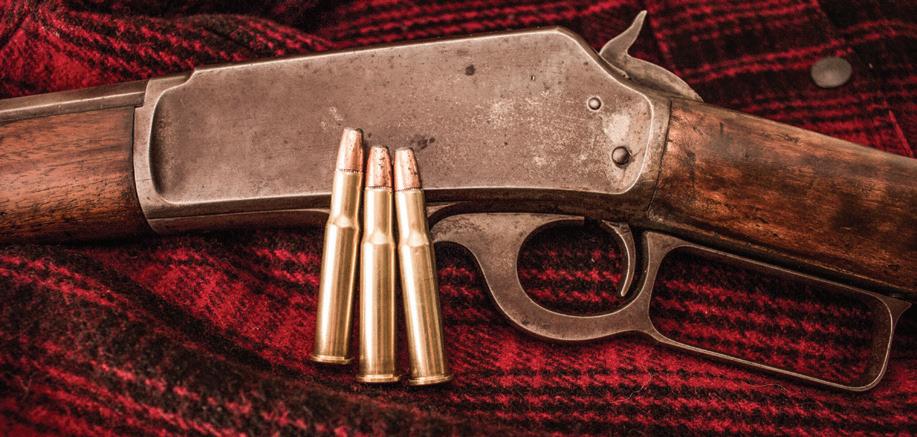
MEANWHILE, THE PROVEN Nosler Partition is also available as a flatnose bullet in .30-caliber at 170 grains, as is their 150-grain Expansion Tip; both make an excellent choice for the .30-30 Winchester and the less-popular .307 Winchester (a rimmed variant of the .308 Winchester). Swift has adapted their A-Frame bullet for use in the lever-action cartridges, including two


offerings in .30-caliber at 150 and 170 grains, in .348-caliber – for the uber-cool .348 Winchester and the Model 71 Winchester – at 200 grains, as well as a 400-grain A-Frame for the .45-70 Government. The Barnes TSX is available in .308-inch-diameter at 150 grains for those needing a leadfree choice.
Hornady has endeavored to revolutionize lever gun performance with their aptly named LeveRevolution ammo line (see what I did there?), which features pointed bullets. Though I said the tubular magazines were relegated to


flat or round meplat bullets, the MonoFlex and FTX bullets in this line use a pliable polymer tip to negate the chance of magazine detonation. This greatly increases the ballistic coefficient of the bullets and extends the range of our common lever-action cartridges.
Hornady’s offerings include: .2535 Winchester at 110 grains, .30-30 Winchester at 140 and 160 grains, .308 Marlin Express at 160 grains, .32 Winchester Special at 160 grains, .338 Marlin Express at 200 grains, .348 Winchester at 200 grains, .35 Remington at 200 grains, .444 Marlin at 265 grains, .45-70 Government at 250 and 325 grains, and .450 Marlin at 325 grains. These projectiles are also available in those handgun cartridges commonly chambered in lever guns, like the .357 Remington Magnum, .41 Remington Magnum, .44 Remington Magnum and .45 Colt.
Federal Premium has recently




introduced a line of ammunition optimized for use in lever-action rifles: the HammerDown line. Using a flatnose, bonded-core bullet with a slightly hollow point, this ammo works wonderfully on big game species, especially on whitetail deer, feral hogs and black bears, though I wouldn’t hesitate to take other species if the range was suitable. According to their website, Federal currently offers the HammerDown in .30-30 Winchester at 150 grains and .45-70 Government at 300 grains. They also offer it in handgun cartridges like the .327 Federal at 127 grains, the .357 Magnum at 170 grains, the .44 Remington Magnum at 270 grains and the .45 Colt at 250 grains. I’ve



used the .45-70 Government ammo for accuracy testing in a Heym over/ under double rifle and it shot very well, and I used the same to take a mature eight-point whitetail in the Catskill Mountains. That deer never knew what hit him, and went less than five steps.
Smaller companies like Tim Sundles’s Buffalo Bore also have some interesting offerings. His .45-70 “Magnum” load – driving a 400-grain bullet at 2,000 feet per second – brings that classic cartridge to a new level of both performance and recoil. It does the job for certain, and in my father’s centennial Browning 1886, what with its curved steel buttplate, it will let you know you’re alive.

So, as you can see, ammunition for Grandpa’s simple lever gun isn’t quite so simple after all. In fact, there are quite a few choices that can breathe new life into an old lever-action rifle, or better yet, give you a reason to seek out your first lever gun.



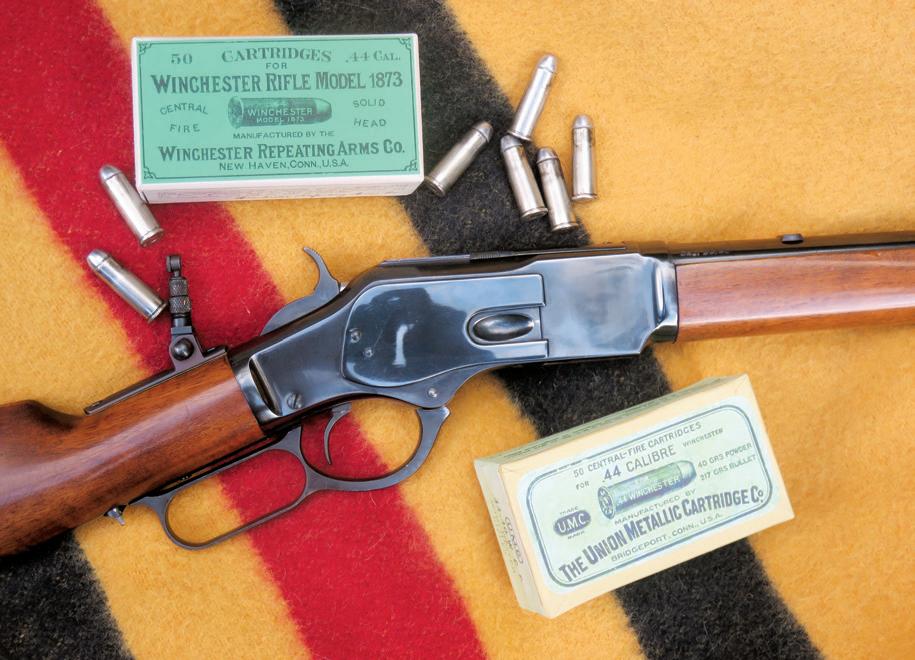 STORY AND PHOTOS BY MIKE NESBITT
STORY AND PHOTOS BY MIKE NESBITT
In Mike Venturino’s book
Shooting Lever Guns of the Old West (available from wolfeoutdoorsports.com), there is a vintage photo of “a young cowboy with a ‘trapper’ or ‘baby’ Winchester Model 1873 saddle ring carbine.” The

old photograph has earmarks of being a studio shot and it is quite likely that the short Winchester carbine was a studio prop and not owned or used by the cowboy at all. Even so, it is a rather striking picture and one of the things that makes it so revealing is how well the rifle is shown. And it might not be an original trapper because it has a nonstandard dovetail front sight. But
the gun is shown well enough in the photo that I wanted one.
What are often called the “trapper models,” with several types of guns, are carbines with barrels shorter than standard. The term “baby carbine” might also be applied, but not specifically unless that’s what the maker called the gun. One example is the Marlin Model 1894 Baby Carbine, which had a lighter-
than-standard barrel but was still 20 inches in length. Those Marlin Baby Carbines also had short magazines, and the “Baby” name was rather well deserved because those carbines had a weight of just over 5 pounds.

Trapper versions of the Winchester Models of 1892 and 1894 were also made. John Wayne carried a Model ’92 carbine with a shorter-than-standardlength barrel in Stagecoach and again as Rooster Cogburn in True Grit Whether those were original trappers or not, I can’t say.
The standard barrel length for a Model 1873 Winchester carbine is 20 inches. Why the imported Uberti versions of that carbine have a 19-inch barrel is something I don’t understand, but being just 1 inch shorter does not put them into the trapper category. The old trapper versions of the Model

1873 often had 14- or 15-inch barrels and now the replicas of those guns, which are made to today’s standards, have 16-inch barrels. With the 16-inch barrels, the new trappers are certainly shorter, in both look and feel, than the standard-length carbines.
CURRENTLY THE MODEL 1873 trapper is offered by Cimarron Firearms Company (cimarron-firearms.com), made by Uberti with the 16-inch barrel and available in .44-40 or .45 Colt calibers (and I’ve seen similar guns advertised in .38 Special/.357 Magnum caliber). Those are fine-looking guns. Even so, they have one characteristic that I do not favor and this is merely a personal thing. On the recently made carbines from Cimarron (and other importers), the front sight is mounted to the top of the forward barrel and

magazine band. That is actually authentic, copying the way it was done on the first models of the 1873. Even so, I don’t appreciate that nearly as much as the later versions, which had the front sight mounted to the top of the barrel just behind that forward barrel/ magazine band. With that feature in mind, I told myself that if I ever found a Uberti trapper in .44-40 with the front sight mounted to the barrel, it would somehow become mine.
Eventually I did find one, or somehow it found me. This one was imported quite a while ago by Navy Arms Company (navyarms.com), and although this isn’t a new rifle, it’s in fine condition. The front sight is just what I was looking for and the rear sight was the Uberti copy of the old Winchester carbine sight. With the 16-inch barrel, this short carbine has an overall length

Five shots, five 10s for Nesbitt and his trapper on a pistol target at 25 yards.

of just 35½ inches with an empty weight of 6 pounds 14 ounces. That’s a handysized little rifle, for sure.
I knew trouble was in store for me if I tried to shoot the trapper with the factory rear sight, mainly because I could just barely see it. Even so, I did try. Just a few shots were fired and those, so it seems, were shot mainly to enjoy the sound of those black powder loads, firing a 205-grain cast bullet with 35 grains of Olde Eynsford 2F powder, as they reported from the 16-inch barrel. That was fun, but the performance of the short carbine simply underlined the fact that I needed a peep sight on this gun.
That was no real trouble because I already had one of the new and very nice Lyman (lymanproducts.com) 1A tang sights for the Uberti ’73 Winchester waiting for the gun. However, the gun did need to have the forward sight mounting hole drilled in the tang and tapped. That was done for me by Allen Cunniff, who actually did the job while I waited. Then the sight was mounted and shimmed in order to put it “in
line” with the existing sights before the carbine’s rear barrel sight was removed. There, now the trapper had a rear sight I could look through but didn’t need to look at.
The only other tiny modification that was made to the sights was to take a flat file and cut the back of the front sight at a 45-degree angle for a little bit just at the top. That gives me a small shiny “bead” at the top of the black (or blued) sight, something that can be seen by these old eyes, even in the dark shadows of the woods. With that, this trapper was ready for action.
THEN THE GUN was ready to be tried on a paper target, shooting from a bench rest. This isn’t a long-range gun, so a target was posted at just 25 yards. The weather was what I like to call a “mackinaw and mittens” day, very chilly after a fresh fallen snow. That didn’t interfere with the shooting at all and the first shot just barely nicked the bottom of the target. A second shot was tried after raising the rear sight just a “guesstimated” amount. With
a 6 o’clock hold, the next shot hit the bottom of the black, right where I was holding. Then the next shot scored a nice and welcome X.
With the gun hitting like that, a second target was quickly posted and that one absorbed five shots, fired fairly rapidly. All hits were 10s on the standard pistol target, with four shots cutting one jagged hole. The group was just slightly to the right of center, but I won’t complain about that, at least not yet. Let me get to know this gun just a little better before I try to do any finetuning on the sights to move the group just a tiny bit to the left. I shouldn’t need to say this, but the accuracy of this trapper carbine with the black powder loads pleases me quite well.
That concluded the “paper work” for getting the carbine sighted in, but my shooting partner Jerry Mayo and I were not ready to quit. We headed down to another range where gongs and silhouettes were hanging, and we both gave the gun a good try at targets from 25 yards to 100 yards, shooting offhand while running ammo
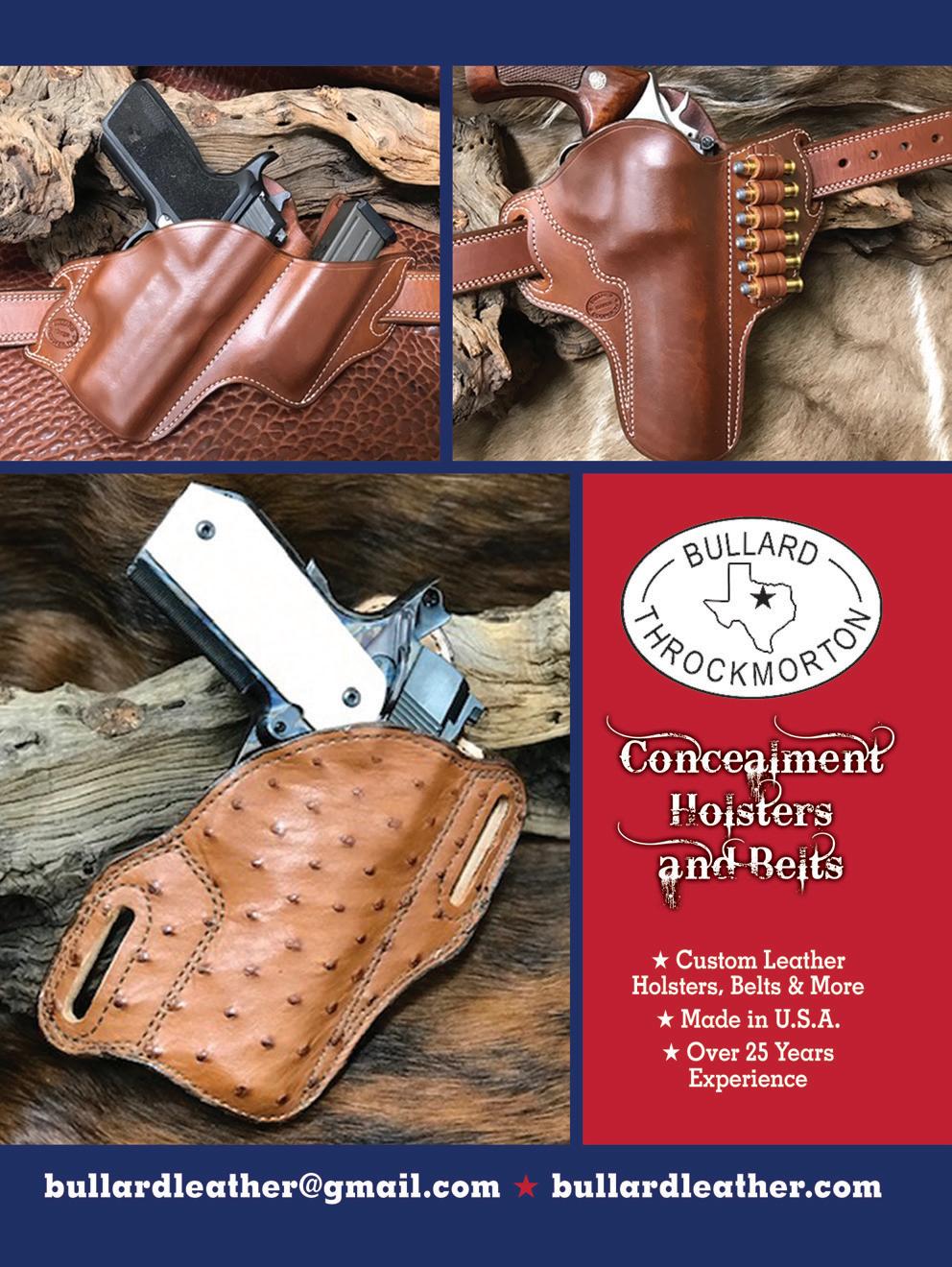


through the magazine. That, of course, is more fun than punching paper from the bench. We both tried a series of just three shots, hitting at close range but missing as the distance increased. I’m planning on giving the gun another sight-in session, probably at 50 yards to make hitting those further targets a bit easier.
After doing the shooting, this little carbine was taken back home where it was cleaned. While it was purchased as a used gun, I’m pretty sure I’m the first to use it with black powder loads because it needed three patches, moistened with Three Rivers Black Powder Solvent (from The Gun Works, thegunworks.com), to come clean. When this carbine gets more experience with black powder loads, and more specifically with bullets lubed with black powder lube, the cleaning will get much easier. And this .44-40 is such a ball to shoot, it will certainly get that chance.


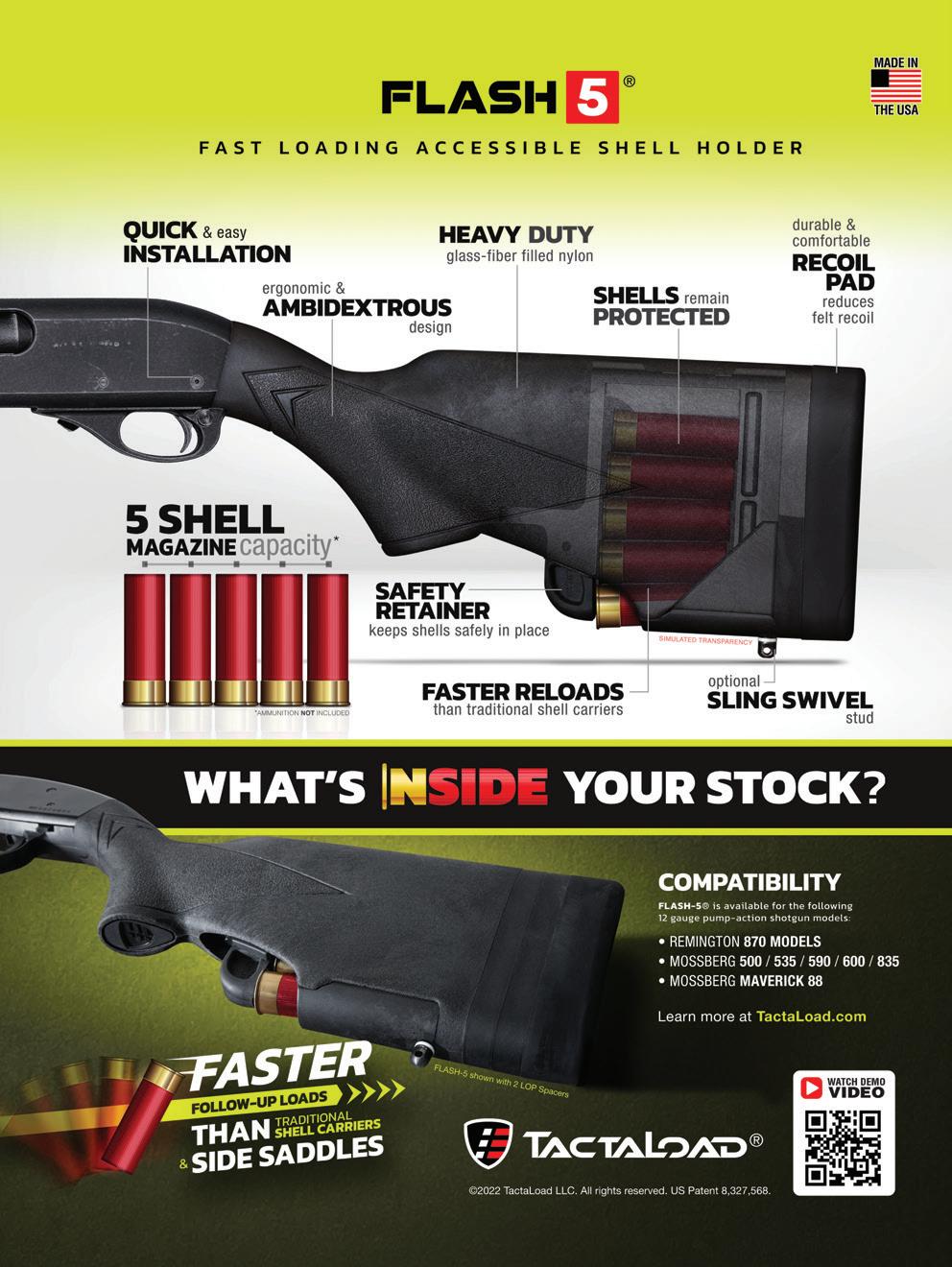
 STORY AND PHOTOS BY LARRY CASE
STORY AND PHOTOS BY LARRY CASE
Icome to you this month tired, worn out and only slightly braindead. I have just returned from Las Vegas and the SHOT Show, you see, and it seems to affect even much younger participants than me the same way – it is overwhelming, exhausting, wonderful and terrible all at the same time.
is the Shooting, Hunting, Outdoor Trade Show held each year in Las Vegas, Nevada, and is sponsored by the National Shooting Sports Foundation. Las Vegas and all of its glory aside, SHOT is the granddaddy outdoor and gun show of the year. It is the World’s Fair, Greatest Show on Earth, and the nirvana of all gun-related trade shows. This year, SHOT had 14 miles of aisles to walk (14 miles!) and while I don’t think I saw half of what was there, it seemed I walked all of it, twice, every day. The SHOT website claims there are over 2,000 booths spread over 800,000 square feet, and by the end of the day when they rang the bell for the show

From new 12- and 20-gauges to shotshells to gun cases, there’s a lot to like about what’s available in 2023’s market.“This is a lot of shotgun for the MSRP of $579,” writes author Larry Case of the CZ-USA 712 G3, one of a number of new shotguns or related products at January’s SHOT Show that impressed him.
to close, I was toast. Then, if you are lucky, you may be invited to one of the companies’ after-hours events! All of these are good and I went to several, but the pace, my friends, is grueling.
So that is the thing about SHOT. It is in Las Vegas, and much of the populace thinks Vegas is the place to be. But yours truly, your humble shotgun scribe, maybe doesn’t think it is the center of the universe. I like going to SHOT, seeing all of my industry friends and making new ones, seeing all of the new guns and other products and learning about them so that I can bring them to you. After a few days in Vegas, though, I am ready to get on a plane and get the heck out of there.
Every year when I return I am always asked, “What did you see out there? Anything good? Anything you can’t live without?” Well, yes and no. Yes, I saw several new shotguns and other firearms that seem good and really interesting, and I would like to try them out. Again, the immensity of SHOT and the miles you travel to see everything is daunting. So do you



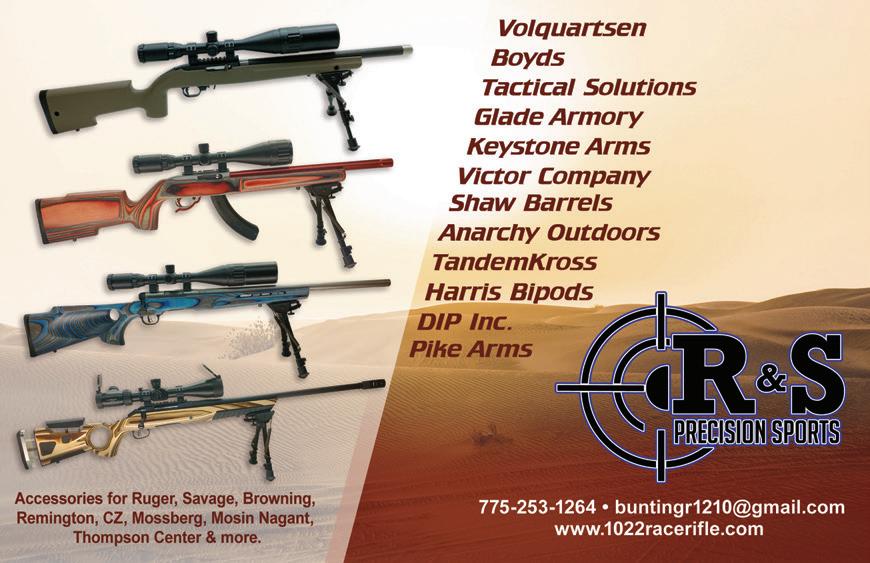
really see all that is there? No, I fear you don’t see half of what is available. But I can tell you some of what I did see, and remember, this space doesn’t allow for much of it. Stay tuned, as I’m sure you will be hearing more of the wonderfulness I saw at SHOT Show.
Those of you in the shotshell world may have noticed that bismuth is back. As a nontoxic choice in pellets,
bismuth may not be quite on the same level as lead, but it certainly outperforms steel. Now with Federal, Remington and Hevi-Shot all coming from the same house, this is a logical move as Hevi-Shot has been producing bismuth shot for a long time. From the folks at Federal, “Never compromise performance. Hit upland birds and waterfowl harder with a payload of 9.6 g/cc density bismuth shot. Sourced from our partners at Hevi-Shot, the industry leader in

pellet technology, Hevi Bismuth is 22 percent denser than steel, delivering more energy downrange. Launched by the FliteControl Flex wad, bismuth pellets pattern and connect with better lethality, and their metallic properties make them safe in both modern and classic shotguns.”
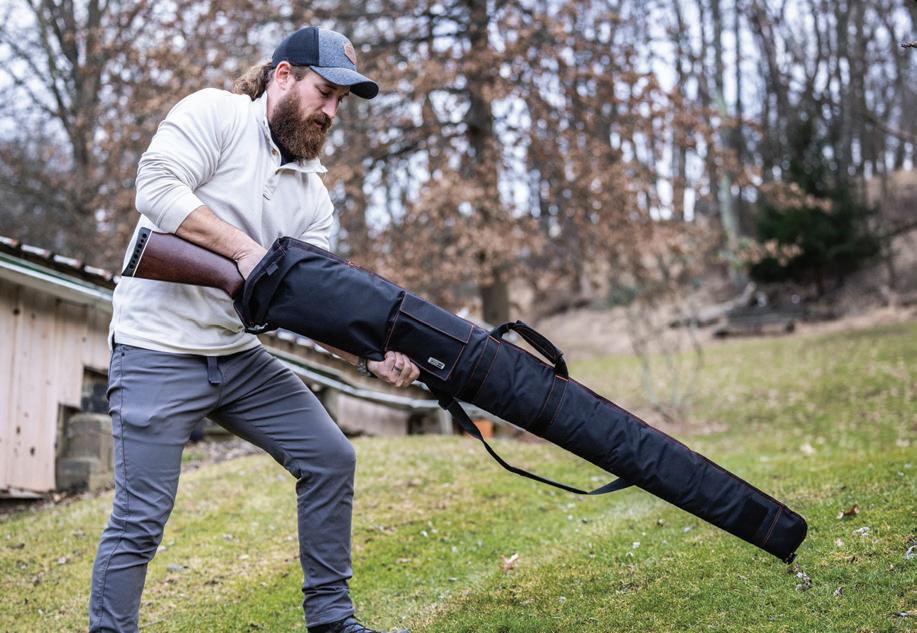
If you can’t use lead, I think bismuth is a killer, and I think you will like some of these options from Federal, Remington and Hevi-Shot.
Visit federalpremium.com for more.











A backbone of Benelli’s upland and clay target shotgun line, the Montefeltro has for years been a favorite of discerning shotgun aficionados. This year, Benelli’s sleek, classically styled shotgun is available in eight different configurations to ensure all shooters, regardless of size, body type or experience level, can dominate in the field and on the clay range.
Benelli didn’t really reinvent the inertia-powered shotgun they have been famous for, but they did significantly change their Montefeltro and M2 line of shotguns. New for 2023, the Montefeltro and M2 shotguns are now upgraded with Benelli’s newest InertiaDriven System bolt for outstanding performance and exceptional reliability. A redesigned bolt handle improves bolt manipulation, even when wearing gloves. This gun’s improved ergonomics complement the handsome walnut stock, pairing perfectly with the deep gloss-blue finish on the sleek receiver and barrel. In truth, the older Montefeltros (and the M2s) were sometimes a pain to load. The new two-piece shell latch makes loading the shotgun a faster and easier task.
The Montefeltro is offered in 12- and 20-gauge chambers with vent-ribbed barrel lengths of 24, 26 and 28 inches, as well as 12- (26-inch barrel) and 20-gauge (24-inch barrel) Compact models. All Montefeltro models come with a Micro Cell Recoil Pad to reduce felt recoil, a shim kit for drop and cast adjustment, and IC, M, and F Crio chokes. I have not fired the new Montefeltro or M2 yet, so stay tuned. Read more at benelliusa.com.
I am hard on guns, I admit it. Guns are meant to be used and I use them. I also hate to clean guns; OK, I am lazy about that sometimes. None of this works well if you spend a wet day in the field. If you haven’t returned home with a wet shotgun that needs to be dried out before cleaning, you haven’t hunted very much. Bone-Dri Rust Prevention Gun Cases make the claim that you can put a damp gun in their case and the case will dry it inside and out. From the company, “Bone-Dri Rust Prevention Gun Cases are the only gun case brand in the world that can eliminate moisture from the entire firearm inside and out by extracting hidden moisture from inside a firearm in order to prevent rust. Bone-Dri gun cases are engineered with Absorbits Moisture Removal Technology.” This gun case is going to revolutionize the gun case world. MSRP $99. Visit bone-dri.com.
The CZ 712 semiauto shotgun has been around for several years and has earned the reputation of a proven performer. I collected a 712 Target Model several years ago and was impressed with it as a soft shooter. Gun companies will often make small changes on next generation offerings, but in truth CZ-USA rebuilt the 712 from the ground up for the G3 model. The major change for this shotgun is the extensively modified gas system. The new 712 G3 draws a greater amount of gas when the shell is fired, resulting in the gun being capable of firing lighter loads. The new 712 gas system also incorporates the use of two pistons, one for heavy loads like waterfowl and turkey shells, and another
for light game and target loads.
Oversized controls on the receiver, shims for adjusting the stock to fit the shooter, and a softer butt pad are also new for this shotgun. Another feature on this gun is the barrel is over-bored (.735), and is furnished with a set of five long Active-Choke system chokes. The CZ 712 G3’s receiver and barrel wear a durable matte black finish that minimizes glare and can be paired with either black synthetic, camo or walnut stocks. The 712 G3 weighs approximately 6½ to 7¼ pounds, depending on stock material and barrel length. This is a lot of shotgun for the MSRP of $579.
Check out cz-usa.com.
Stoeger Industries has been busy the past few years adding to and bringing new innovations into their extensive line of handguns, air rifles and shotguns. Their shotgun side has really stepped up its game, specifically in the M3500, the M3020 (20-gauge models), the P3500s, the pump guns and the M3000 lines.
Stoeger shotguns have always been known as workhorse shotguns at a good price, and now all of these guns have a scaled-down, slimmer, more ergonomic feel for improved handling. This leads to consistent shouldering and enhances downrange accuracy. The grip is also thinner and the view from the receiver to the rib is lower. Stoeger engineers worked to add more purposeful features to benefit clay-busters and bird hunters alike. An oversized bolt handle boosts functionality when the hunter’s hands are cloaked in heavy gloves. The safety is bigger, the forend is redesigned, and







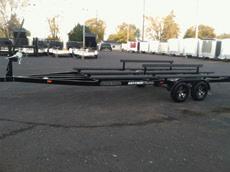




the magazine cap is easier to grip and remove. A beveled loading port makes reloading quick and efficient, and a new recoil pad prevents shoulder abuse even when firing heavy loads. The cheek piece, which is available on all models besides the satin walnut, adds comfort but is also removable to ensure fit-andfeel customization.
Pump-action fans will appreciate the P3500’s checkered synthetic stock with an integrated swivel stud


to ensure easy sling attachment, and like the M3500 series, the grip has been slimmed. Twin barrel steel bars promise repeatable, no-stick pump action, and the rotating bolt head ensures a positive steel-to-steel lockup that ups strength and overall durability. Several models with different stocks and camo patterns are available. The M3500 12-gauge with black synthetic stock goes for $669. See stoegerindustries.com.
Editor’s note: Larry Case has been a devoted outdoorsman since he was a child. He will admit to an addiction to turkey hunting (spring and fall), but refuses any treatment. He enjoys the company of gobblers and cur dogs that are loud and people who speak the truth softly. Case served 36 years as a game warden in West Virginia and retired with the rank of district captain. You can check out his podcast and other stories at gunsandcornbred.com.


Tap Rack Holsters is a leading provider of premium American-made gun holsters and knife sheaths. Our products are the result of 40 plus years of combined experience in the military and law enforcement field using American made materials. Every Tap Rack holster and sheath is handcrafted using extreme care, precision and built to last because we’re dedicated to providing premium quality products our customers can rely on.

a PREMIUM QUALITY
a FULLY FUNCTIONAL
a LIFETIME WARRANTY
a CUSTOM BUILDS
a BUILT FOR EXTREME USE
a MADE IN AMERICA
a BUILT WITH AMERICAN MATERIALS AND PARTS
a MADE BY AMERICANS AND VETERANS
FBIMiamiFirefight book details historic 1986 firefight between G-men and bank robbers that changed how the bureau, law enforcement and others train, as well as shares special agents’ personal stories.
 STORY BY PAUL PAWELA • PHOTOS BY FBI
STORY BY PAUL PAWELA • PHOTOS BY FBI
In my four decades as a firearms instructor, I’ve received training from – and trained with – the best shooting instructors in the world, and I have read the books they’ve authored at length.

If I were asked to choose one book as the bible on gunfighting, I know which one I would choose. Hands down, it would be

the one by retired FBI special agent Edmundo Mireles and his wife, former FBI agent Elizabeth Mireles, titled FBI Miami Firefight: Five Minutes That Changed the Bureau
The book offers lessons not only for law enforcement officers in a defensive situation but also for civilians who carry firearms. Those who have a gun on their person – whether military, police or civilian – do so because they understand the degree of evil in the world and acknowledge that it is a
good idea to be armed in the face of that evil.
Being armed gives you a greater likelihood of being involved in an armed encounter or, more to the point, a gunfight. So how do you prepare for this potential encounter?
Consult an expert. And of course, there is no better expert than someone with personal experience. Someone who has survived a lethal encounter and is willing to discuss it without boasting, embellishing
or grandstanding. Someone who can accurately and methodically relive their harrowing encounter and share the hard-won lessons so you might be better prepared for just such an encounter one day. This is precisely what Ed and Elizabeth Mireles have achieved with their 2018 book.
is a must-read for anyone who carries a firearm. Not only are both authors former FBI agents, but they are married to each other, which brings an added dimension as they each describe their own personal perspective on the harrowing lethal encounter that would go down in history as the FBI’s most famous gunfight. The FBI shootout would also become known as “The Massacre in Miami.”
For those who may not remember the events of April 11, 1986, here is a summary:
Eight seasoned, highly motivated and well-trained FBI agents, including Ed Mireles, were on the trail of two killers who had robbed armored cars and banks with precision and

extreme violence; these were evil men trained in tactics and marksmanship and they were not afraid to use those skills. Then, in an epic climax on the streets of Miami, the good guys faced off against the bad guys in a bloody gunfight that left the two bad guys dead – but also took the lives of two

heroic FBI agents, critically injured another three brave agents and wounded two more.
To put things in perspective, the incident was more violent than the classic Gunfight at the OK Corral in Tombstone, Arizona. In that gunfight, it was recorded that 30 shots were fired in 30 seconds, resulting in three dead bad guys and two seriously wounded good guys. The FBI shootout, in contrast, lasted about four minutes and involved at least 150 rounds, four deaths, and many more injured. The Mireleses’ book covers what happened on that dreadful day nearly 37 years ago.
The book also touches on Ed Mireles’s early life and career in the FBI. And why is that important? Because his story is what makes America great: a poor kid from an immigrant family joins the military, pursues his degree, and gets accepted into the FBI. Mireles’s story underscores that showing drive and commitment will allow anyone to access and share the American dream.
Without spoiling too much of this fine book, the authors go into great detail regarding FBI training and how that methodical training paid off for Ed on the day of the infamous

gunfight. Moreover, the book emphasizes that firearms training should never stop, whether you are an FBI agent or a concealed carry license holder. Training and more training with proper mental preparation go hand in hand.
THE WORD “GUNFIGHT” implies that bullets will fly in both directions and too often in training, students give little thought that they could be seriously wounded or even killed.
Mireles recounts the horror of witnessing bad guys becoming
bullet sponges, taking multiple hits from different calibers of firearms, and still returning fire on the good guys. He shares the hell that he and his teammates experienced as they underwent an intense volume of incoming rounds that shredded them. As you might imagine, it was a bloody affair, with one of the bad guys losing over 50 percent of the blood in his body before he expired.
FBI Miami Firefight also covers some unique ground by addressing the trauma of being injured and the grueling road to healing, the harsh
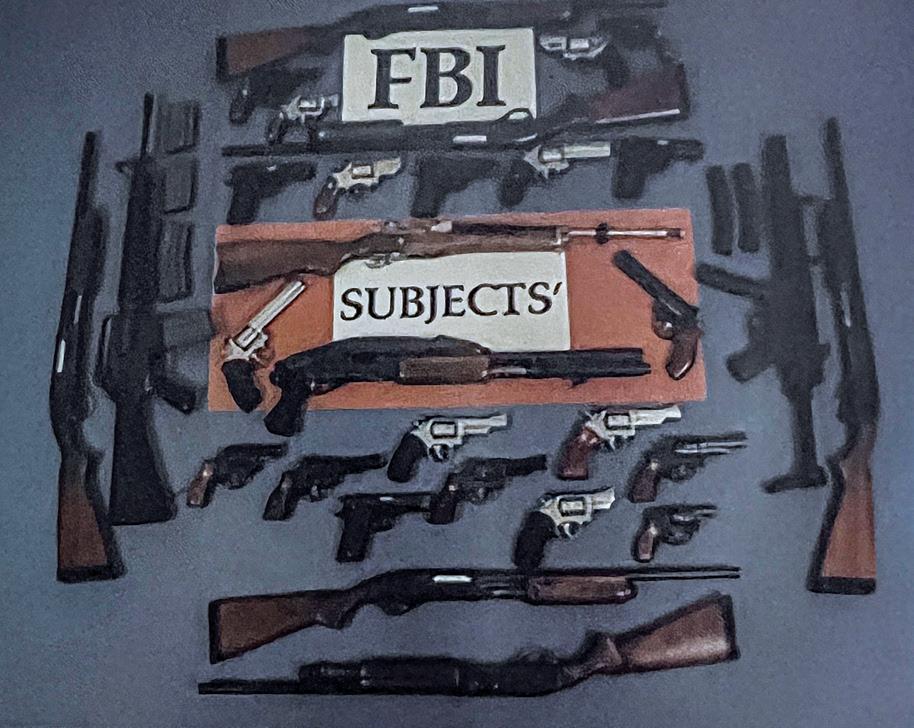
reality of gut-wrenching farewells to friends at funerals, interactions with surviving family members, and the inevitable post-traumatic stress disorder/survivor’s guilt.
The book is even more poignant as it recounts the love between the two authors. Elizabeth’s devotion to Edmundo carried the couple through the horrific aftermath when he was so severely injured. In fact, she washed the blood off his body to prepare him for his operation because the hospital staff was so overwhelmed with incoming patients from the gunfight.

Elizabeth not only prepared him for his long operation, but she stood by him as he struggled with physical therapy every day for two years. She also stood by him as he endured PTSD nightmares and the accompanying emotional outbursts. Many marriages fail under these circumstances, but the Mireleses’ love is enduringly strong.
THE BOOK ALSO explains how the firefight changed the FBI and law enforcement in general. Police shifted to semiautomatic handguns. Body armor was improved and enhanced. Some of the most detailed ballistic studies ever performed were accomplished by studying better ways of hitting bad guys and stopping them.
Law enforcement firearm training also changed dramatically, from standing still and shooting at paper targets to shooting while running, dodging and ducking targets that are also running, dodging, ducking and shooting back. We can now accomplish this thanks to manmarking cartridges, where bullets go in both directions.
Likewise, the best modern courses now emphasize shooting one-handed in case the other hand is injured, alternating dominant and
nondominant hands. The best courses also acknowledge that, no matter how bad the situation is, you must have a belief that you can win, you must win,
your partners need you to win for them to stay alive, your family needs you to win, and so on.
FBI Miami Firefight underscores the training and the physiological changes that happened in the historic firefight, and it also establishes that the FBI agents of the famous C-1 squad are, in fact, the founding fathers of what is known today as reality-based training.

The book is an absolute must for anyone who carries a firearm because it truly is the bible of gunfighting. The book is available at edmireles.com.
And that’s my two cents!
Author’s note: I wish to thank Edmundo Mireles for being a role model, mentor and friend.
Editor’s note: For realistic self-defense training, see assaultcountertactics.com. Author Paul Pawela is a nationally recognized firearms and self-defense expert based in Florida.



Decked out in dress blues at the Marine Corps Ball, offduty police officer leaps to resuscitate crash victim – twice.
STORY BY NICK PERNA PHOTO COURTESY OF SAN MATEO POLICE DEPARTMENTnce a Marine, always a Marine.” Like law enforcement, the Marine Corps is an organization where its members achieve lifelong membership into the organization they have sworn an oath to. Cops and marines also maintain lifelong kinships with those they have served.
Many veterans are drawn to law enforcement. For me, I have seen many similarities between my time in the military and my time as a police officer. As a whole, veterans tend to be better prepared for the rigors of a law enforcement career and adapt quickly to it.
Both lines of work also emphasize the importance of helping others. It is ingrained in soldiers and cops alike to go to great lengths to help others in times of extreme need.
OFFICER FERNANDO RAMIREZ is a member of the San Mateo Police Department in Northern California. He is also a marine. Every November, marines get together to celebrate the birth of the

Corps. The Marine Corps Birthday, as it is known, is generally celebrated at the Marine Corps Ball, an event held throughout the country.
Officer Ramirez was attending the ball when he observed a driver crash his vehicle into a building in South San Francisco. While dressed in full USMC dress blues, he ran to the scene to assist. He located an intoxicated driver who wasn’t breathing and had no pulse.

He summoned the skills learned jointly in the military and in law enforcement to conduct CPR. Through his efforts, he was able to bring the subject back to life. While awaiting medics, the subject again stopped breathing. Officer Ramirez again initiated life-saving measures, bringing
the subject back to life a second time.
The driver was then transported to a nearby hospital, where he survived.
The few, the proud. “The few” consists of those who are willing to risk their personal safety to help others. “The proud” is everyone else.
Editor’s note: Author Nick Perna is a sergeant with the Redwood City Police Department in northern California. He previously served as a paratrooper in the US Army and is a veteran of Operation Iraqi Freedom. He also has a master’s degree from the University of San Francisco. He is a frequent contributor to multiple print and online forums on topics related to law enforcement, firearms, tactics and veterans issues.



